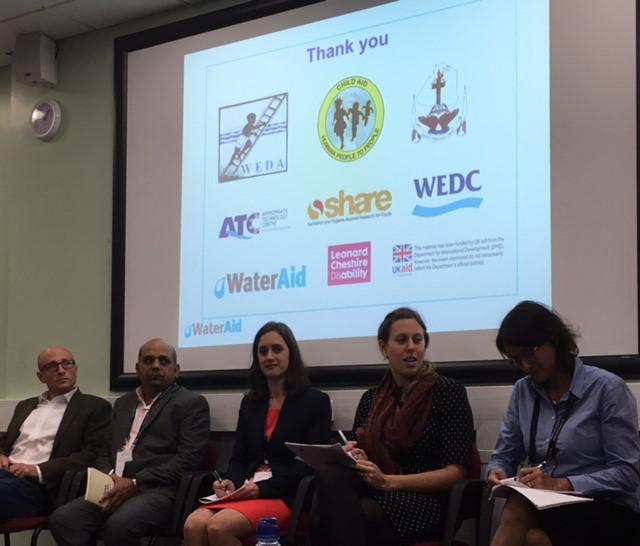Evidence Uptake in the WASH Sector: What Works?

The question on everyone’s lips in development is ‘what works?’. Unfortunately, there’s no silver bullet. If there was, there might not have been a five-day conference taking place in London in September: the ‘What Works Global Summit’.
SHARE hosted a panel session at the conference focusing specifically on evidence uptake in the WASH sector. Our range of panellists offered different perspectives of the successes and challenges of evidence uptake in relation to SHARE-funded projects, and their recommendations for future funders, researchers and programme managers.
SHARE-ing our perspectives
Our first presenter was Anna Nileshwar from DFID, who offered a donor’s perspective of evidence uptake. She explained how DFID approaches RIU and why’s it’s important. One of the key successes of SHARE’s RIU activities has been adequate resourcing: RIU makes up an impressive 26% of SHARE’s research budget, including a full-time member of staff dedicated to RIU. While there are few limitations in how this budget is spent, there are clear targets for RIU in DFID’s logframe, and monitoring RIU is a critical component to find out what works.
Building on this, Emily Balls, Monitoring and Evaluation Officer at SHARE then gave an overview of outcome mapping, a tool SHARE is using to measure research uptake. In contrast to logframes, which can be perceived as quite linear, outcome mapping is a rather complex, multidimensional (often messy!) tool. Although it’s resource- and time-intensive, outcome mapping has provided a sense of shared ownership, enabling partners to engage stakeholders early on, and even develop new cross-sector collaborations. While some great results are coming out of it, the process is more important than the final product.
Oliver Cumming from LSHTM then gave a researcher’s perspective on how WASH research can be used in practice. He started off by making a distinction between the perception of evidence and research. Evidence used for decision-making needs to be compelling, actionable and timely in order to be implemented in policy. On the other hand, rigorous research findings are often inaccessible, ambiguous and have a long gestation. These two sides must be reconciled. Using an example of a SHARE study on WASH and maternal health, he demonstrated how research findings can have an impact, feeding into the WHO-led WASH in HCF initiative.
Jane Wilbur from WaterAid used the example of the SHARE-funded Undoing Inequity project in Uganda and Zambia, highlighting how they engaged policymakers and other stakeholders from the very beginning. In 2011, before the project began, SHARE and WaterAid convened a roundtable meeting with international policymakers to understand why inclusive WASH wasn’t delivered at scale. At the time, no evidence existed (other than case studies) about the barriers that disabled people face when accessing WASH. Undoing Inequity involved key stakeholders at every stage of the project, and ensured marginalised people were involved in trialling resources. Research findings from this project was used as evidence for a DFID inquiry on disability and development, and the DFID disability framework included WASH as a workstream.
Our final speaker was Deepak Saxena from the Indian Institute of Public Health. As the Principal Investigator of the WASH and CLEAN study, co-funded by SHARE, he gave an overview of the successes and challenges of engaging policymakers in an Indian context. He noted there was a huge political will for improving WASH, but challenges arose around competing priorities within health care facilities – WASH wasn’t always at the top of everyone’s list. He noted that research is usually spearheaded by academics (not practitioners or managers), which often leads to limited use of the findings. However, several notable successes have been made, including changes in policy to ensure a key WASH contact at each health care facility, and a new health centre has incorporated WASH in the design of a new building.
So… what works?
From our range of talks, it became clear that there’s no one way to achieve successful research uptake – much of it is context-dependent. But in all these contexts, research uptake involves three key elements: multiple stakeholders, trusting partnerships, and a range of skillsets and expertise – be it research, policy, or the brokers in between.
